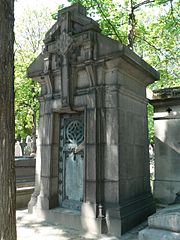Tomb
From Wikipedia, the free encyclopedia.

A tomb is a small building (or "vault") for the remains of the dead, with walls, a roof, and (if it is to be used for more than one corpse) a door. It may be partly or wholly in the ground (except for its entrance) in a cemetery, or it may be inside a church proper or in its crypt. Single tombs may be permanently sealed; those for families (or other groups) have doors for access whenever needed.
See also
- List of Egyptian tombs
- cemetery
- funeral
- grave
- catacombs
- mausoleum
- Tomb of the Unknown Soldier
- Cadaver tomb
- Chamber tomb
- Megalithic tomb
Tombs in the Bible
This entry incorporates text from the public domain Easton's Bible Dictionary, originally published in 1897.
Tombs - of the Hebrews were generally excavated in the solid rock, or were natural caves. Mention is made of such tombs in Judges. 8:32; 2 Samuel. 2:32; 2 Kings 9:28; 23:30. They were sometimes made in gardens (2 Kings 21:26; 23:16; Matthew 27:60). They are found in great numbers in and around Jerusalem and all over the land. They were sometimes whitewashed (Matt. 23:27, 29). The body of Jesus was laid in Joseph's new rock-hewn tomb, in a garden near to Calvary. All evidence is in favour of the opinion that this tomb was somewhere near the Damascus gate, and outside the city, and cannot be identified with the so-called "holy sepulchre". The mouth of such rocky tombs was usually closed by a large stone (Heb. golal), which could only be removed by the united efforts of several men (Matt. 28:2; comp. John 11:39). (See Golgotha, Sepulchre.)

